Ever since Rosemary’s Baby, The Exorcist, and The Omen revitalized gothic religious horror in the 1970s, the “troubled priest has to perform an exorcism” character has been a reliable fixture in horror. Is the priest troubled because he’s in love? Is he having a crisis of faith? Is he the only one who believes in the reality of demons, and the bureaucracy of the church has his hands tied? Maybe all three!
Over the decades there have been subversion, reversions, parodies, rote rehashes—I’ve tried to round up some of the most interesting ones below.
To be clear, this is not a ranking of Exorcist films, although they will feature heavily throughout. Hell, if you want that:
- Exorcist II: The Heretic
- Exorcist: Believer
- Renny Harlin’s Exorcist: The Beginning
- Paul Schrader’s Dominion: Prequel to the Exorcist
- Exorcist III
- The Exorcist (TV series) (Criminally Cancelled After Only Two Perfect Seasons)
- The Exorcist
There, a ranking list inside another ranking list! Exor-ception! Ahem.
There are a lot of exorcism movies out there. Many of them are terrible. What I’m going to attempt here is a definitive ranking of the exorcists of horror, by exorcism style. I’m not gonna get all of them because, as I say, they are Legion, and also many of them are so bad even I couldn’t make myself sit through them. However! As always, if I missed your favorite exorcist (Why do you have one of those? Who hurt you?) let me know about them in the comments!
Now, may the power of worst-to-best listing conventions compel you!
23. Father Phillip Lamont — The Exorcist II: The Heretic
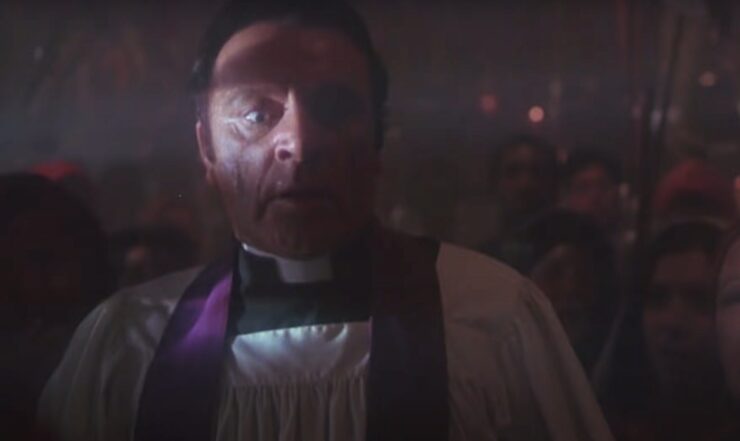
The Exorcist II: The Heretic is widely considered one of the worst films ever made. Those who think this are correct. It’s a terrible, wrong-headed movie, that bungles all the important points and imagery from The Exorcist even worse than Exorcist: Believer did earlier this month. And one of the worst elements is this film’s exorcist, Richard Burton’s Father Philip Lamont. The first exorcism we see from this dude goes terribly awry because of his devotion to vibes—his exorcisée is engulfed in the flames from the candles he used to light the room. Later, when he tries to “exorcise” Regan MacNeil’s evil doppelgänger (it’s complicated) he does so by losing his mind at the sight of a teenage girl in a nightgown and making out with her neck for a while, before punching her chest until it explodes. Then he pulls her heart out. Meanwhile, the “good” Regan MacNeil (again, it’s complicated) is the one actually exorcising… herself? The world? Look, it’s not a good film.
Vatican or Vatican’t? The whole reason for this film is that Father Lamont is sent to investigate Father Lankester Merrin’s exorcism from the first movie. There’s talk that Merrin might be the titular heretic, and also the Church is trying to downplay the existence of Satan, and Merrin’s writings about demons aren’t going to help.
How’s Your Faith, Father? It’s not great! And flambéing his last exorcism subject didn’t help.
You Can’t Spell Exorcism Without an S, an E, and an X: Again, he’s driven mad by the site of a teen in a nightgown.
Rite or Violence? He punches her chest until it explodes.
Quid tu hic? I’m sorry to this priest, but Philip Lamont SUUUUUCKS. His loss of faith is nowhere near as compelling as Damian Karras’, and he’s a seriously subpar exorcist. Hence, he comes in at the bottom of the list.
22. Regan MacNeil — The Exorcist II: The Heretic
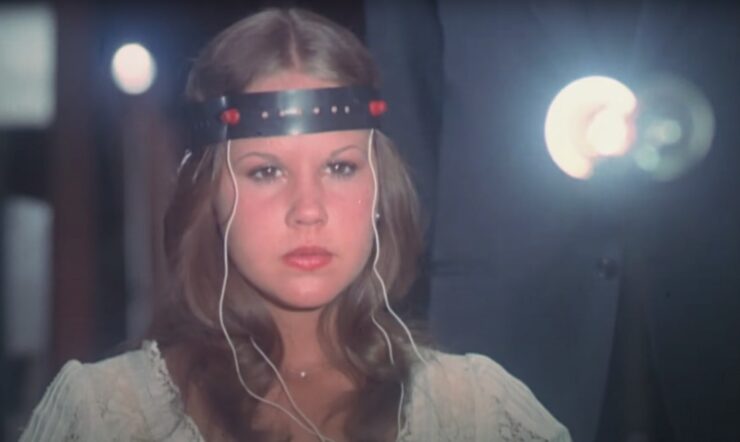
At the beginning of Exorcist II, Regan seems fine! She’s living with her mom’s old assistant for some reason, and doing biofeedback experiments to try to recover her memories of the exorcism. Then she develops a telepathic link with an African child (I think) and fights Pazuzu (who appears as locusts for some reason) through the power of cultural appropriation.
Vatican or Vatican’t? The Vatican sent Philip Lamont in to investigate Merrin’s death, but I don’t think they know anything about Regan’s journey in this film, and I can’t imagine they’d approve if they did.
Rite or Violence? Her method is to use a bullroarer ritual! Which she really shouldn’t know how to do? But the power of a white savior in a nightgown compels us, I guess.
You Can’t Spell Exorcism Without an S, an E, and an X: The good Regan is utterly virginal, only wears white and beige, and (literally) raises doves. In fact every time she’s in a room there’s some sort of dove imagery. Meanwhile her evil doppelgänger is a total slut, a fact evidenced by the wearing of eyeliner.
Rite or Violence? …bullroarer.
Quid tu hic? She’s not really an exorcist, but she tries her best, which is why she lands the slot above her own would-be exorcisor.
21. Chris MacNeil — Exorcist: Believer
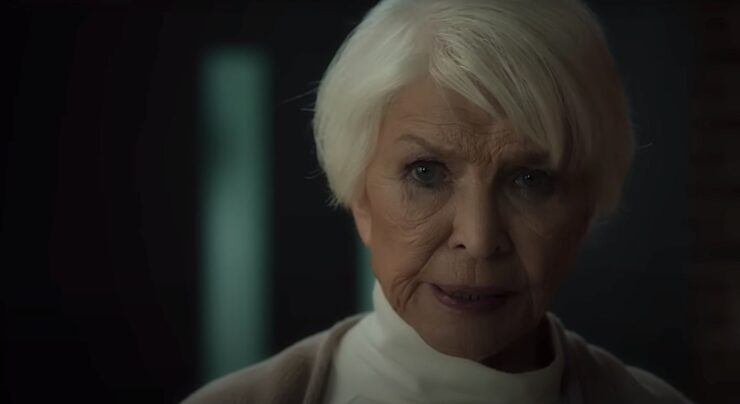
Ooof.
Among the many sins of The Exorcist: Believer, it brings Ellen Burstyn back as Chris MacNeil, who, after writing about her daughter’s exorcism, has become a kind of freelance exorcist herself. She’s estranged from Regan, and seemingly hoping that helping other families dealing with possession will… make Regan start talking to her again. (If you don’t think that makes any sense, you are not alone.) The movie puts about half an hour into building her character up before it sends her into a room, alone, with a possessed girl. She tries to order the demon out, the demon mocks her with quotes from The Exorcist, and Chris lasts all of five minutes before the demon overpowers her and stabs her in the eyes with a cross, in a gross callback to Pazuzu raping Regan with a crucifix.
Vatican or Vatican’t? They wouldn’t let her attend her daughter’s exorcism, “probably because I wasn’t part of their damned patriarchy”—or because, I don’t know, you’re not qualified for this job, Chris.
How’s Your Faith, um, Regan MacNeil’s Mother? Chris has studied exorcisms across cultures, and goes with the “it works because people believe it works” idea, even though that flies in the face of her own direct experience.
You Can’t Spell Exorcism Without an S, an E, and an X: The demon repeats the “you know what she did, your cunting daughter” line, in Burke Dennings’ voice, to freak her out.
Rite or Violence? Neither, she tries to exorcise a demon “in the name of my daughter, Regan” as though that’s going to have weight?
Quid tu hic? She is woefully unqualified to be an exorcist.
20. Nurse Ann, Father Maddox, Dr. Beehibe — Exorcist: Avengers Exorcist: Believer
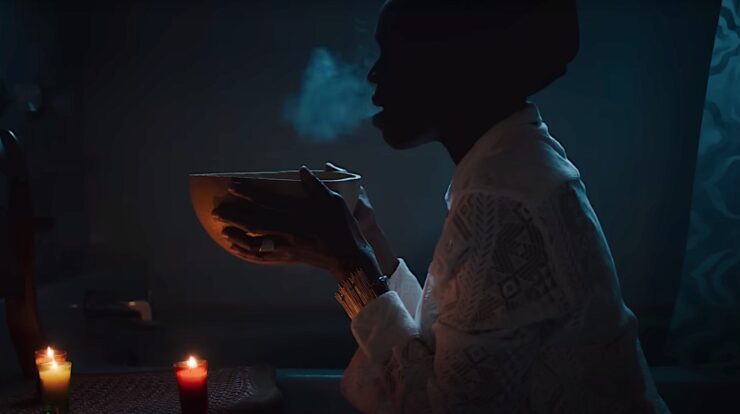
I’m putting the rest of the Exorcist: Believer chuckleheads cast on the same line. In Exorcist: Believer, several people from different religious traditions team up to attempt an exorcism. They are: a nurse named Ann, a devout Catholic who stopped just short of taking vows to become a nun; Stuart, a Pentecostal layman; Dr. Beehibe, a Hoodoo rootwork healer; a Baptist minister; and the parents of the two possessed kids, two of whom are Baptists, and one of whom is a skeptic. Eventually, Ann’s parish priest Father Maddox also joins in, despite the Diocese explicitly refusing to approve the exorcism.
Vatican or Vatican’t? The diocese does not approve the exorcism, Father Maddox for some inexplicable reason deputizes a Catholic nurse to do it, then comes in at the end to try to save the day, an attempt that fails hilariously.
How Are Your Faith(s), Interdenominational Council? They all very much believe in what they’re doing, and gradually start respecting each other’s methods. All the work gets undone by one of the parents, though—which is why parents should never attend exorcisms, Chris MacNeil.
You Can’t Spell Exorcism Without an S, an E, and an X: The demon throws Nurse Ann’s abortion in her face a couple times, and she allows that to mess up her game.
Rite or Violence? Several different rites! The reason I’m ranking these people higher than Exorcist II is that the one thing I liked about the film was the respect they show for each faith tradition. We see a bit of the Catholic Rite, some Hoodoo, some Vodou, and Baptist prayer. There’s also a skeptic, Victor Fielding, who tries The Power of Love.
Quid tu hic? The only one who shows any real aptitude is Dr. Beehibe, but they all fare better than Chris MacNeil, so they just edge her out.
19. Father Francis ‘Frank’ Delaney — The Amityville Horror
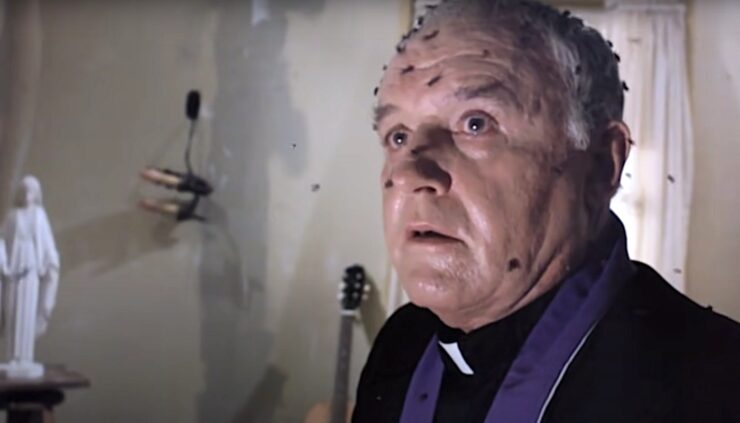
The Amityville Horror follows the Lutzes as they move into a new house and ignore dozens of warning signs that it’s haunted af. (By the way, this is the movie where the haunted house is built on Indigenous sacred ground, not Poltergeist.) At the family’s request, Father Delaney comes over to bless the house, but when he’s swarmed by flies and hears a voice growling at him to get out, he turns tail and flees. The diocese ignores his calls for an exorcism, unconvinced by, um, lots of flies and a mean voice. He makes a couple half-hearted tries to check in on the Lutzes but is thwarted by that classic infernal machination “static on the landline” until he finally takes action! By driving back to the house! Weeks later! At which point Satan shows his full power and tampers with the car’s brake line. Rather than simply, I don’t know, taking a bus, he goes back to his church to ask God to fix it, and is promptly struck blind and catatonic.
Vatican or Vatican’t? The diocese isn’t convinced! But to be fair he doesn’t give them much evidence beyond the flies.
How’s Your Faith, Father? I would say it seems fine, except for the part where he runs away from the first demonic challenge he faces, which is, once again, literally just flies.
You Can’t Spell Exorcism Without an S, an E, and an X: Nope!
Rite or Violence? Neither!
Quid tu hic? He doesn’t do enough to earn a higher spot on the list, but given how incompetent some of these exorcists have been, I’m taking it on faith he could have done better if he’d just gotten past that crackling phone line.
18. Father Andrew Kiernan Gabriel Byrne/Father Houseman — Stigmata
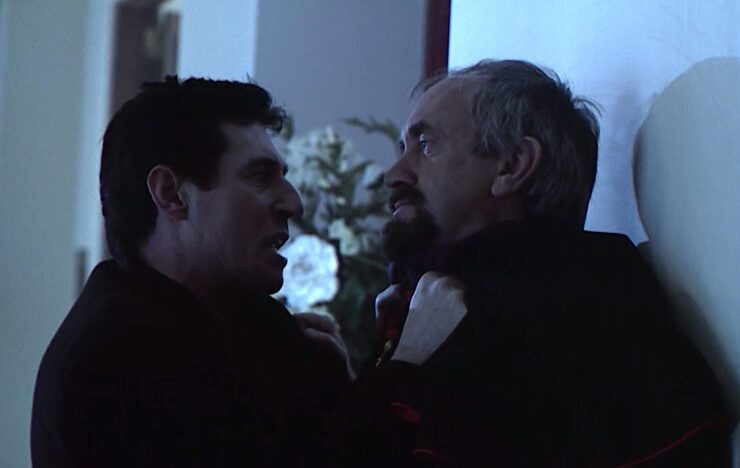
(heavy sigh) This entry’s gonna be long, but, man, this movie. Let me begin with a brief anecdote: A billion years ago, in 1999, I went to see Stigmata in the theater. About, I don’t know, one minute in, there’s a voiceover of a priest reciting words that are later purported to be the words of Jesus, written into a “secret gospel” which has been suppressed by the Catholic Church. At that moment, a billion or so years ago in a movie theater in Florida, Young Leah said, pretty loud: “That’s just the Gospel of Thomas”, and sat through the rest of the film seething with impotent rage.
I’m putting Stigmata’s two priests in the same entry because they’re equally bad exorcists. Stigmata are a phenomenon in which a person with intense faith experiences some of the wounds Jesus suffered during the crucifixion. Stigmata asks: What if an atheistic hairdresser from Pittsburgh got them because her mom gave her a haunted/cursed/possessed rosary that used to belong to a stigmatic priest? Other hard-hitting questions from the film: What if the Catholic Church… was a bureaucracy? What if… The Exorcist was made for MTV circa 1991? What if one Jesuit priest informed another that there are about 35 gospels and the other Jesuit was shocked by this? Even though he would absolutely have learned that in seminary? What if a Jesuit priest, still in shock, gasped, “There’s no one gospel in Jesus’ actual words???” a thing that literally anyone with even a cursory knowledge of the New Testament knows? What if a Jesuit priest also said: “We’re all blind men in a cave looking for a candle that was lit 2,000 years ago…” apropos of nothing, which is very poetic but also sounds a lot more like a description of Hanukkah than anything in Catholicism. What if—sorry. Let me move on, or we’ll be in this entry all day.
Father Andrew Kiernan investigates the stigmata of hairdresser Frankie Paige, inadvertently uncovering a conspiracy around a gospel that’s supposed to be in Jesus’ own words. (Again, it’s just the Gospel of Thomas, you can read Thomas O. Lambdin’s translation here if you want. And here’s Professor Dale Martin’s Yale lecture on it if you’d like to watch that, it’s pretty cool!) It turns out she’s been possessed by the soul of the priest, Father Alameida, who was excommunicated for translating the controversial gospel. And for some reason the priest’s soul is killing her, I guess, while also using her hands to write gospel quotes on her walls in Aramaic, even though all the versions of The Gospel of Thomas we’ve discovered so far are in Coptic and Greek. Father Houseman tries to exorcise the spirit of Alameida—primarily by choking Frankie most of the way to death—and then Kiernan tries that classic exorcist’s trick of asking nicely.
Vatican or Vatican’t? The Vatican’t allow this Gospel that was first published in English in 1959 to be seen by the general public; the Vatican attempt to murder a hairdresser from Pittsburgh.
How’s Your Faith, Father? Much hay is made of Kiernan being “more of a scientist than a priest”—a thing that is super not an issue in the Jesuit order—and at one point, having exhausted all other options, the priest… resorts to prayer. For all of 40 seconds! Then Frankie interrupts him, saying: “I’ve never seen you pray before” (nb: they’ve known each other about a week), and he replies: “I haven’t prayed for a very long time,” except we saw him serve Mass like three scenes ago.
Meanwhile Houseman is involved in a giant Vatican conspiracy because he thinks allowing the actual “words of Jesus” will destroy the Catholic Church, so I think it’s safe to say his faith is shaky at best.
You Can’t Spell Exorcism Without an S, an E, and an X: The “possession” that Frankie goes through is essentially her experiencing Father Alameida’s stigmata. The attacks are filmed on a spectrum somewhere between “mid-90s music video” and “soft-core 2am Cinemax movie”, they’re all upsettingly sexual, and then it’s somehow made even worse when you realize that these attacks are a dead priest’s soul, experiencing stigmata, through Frankie’s body. And then at the end she and Father Kiernan are a couple, maybe? (I want the sequel where the 50-something Irish Jesuit moves into the 23-year-old’s snazzy ‘90s loft and these two crazy kids try to make it work.)
Rite or Violence? Houseman tries to exorcise the priest’s soul from Frankie, and when it doesn’t work he chokes Frankie and almost kills her. Then Father Kiernan swoops in and throws Houseman across the room, and the bed explodes into flame as the soul of the priest speaks with his own voice through Frankie’s mouth. I think.
Quid tu hic? This movie is terrible, and both of these priests are bad at their jobs.
17. Father Thomas “Tom” Hogan — Ouija: Origin of Evil
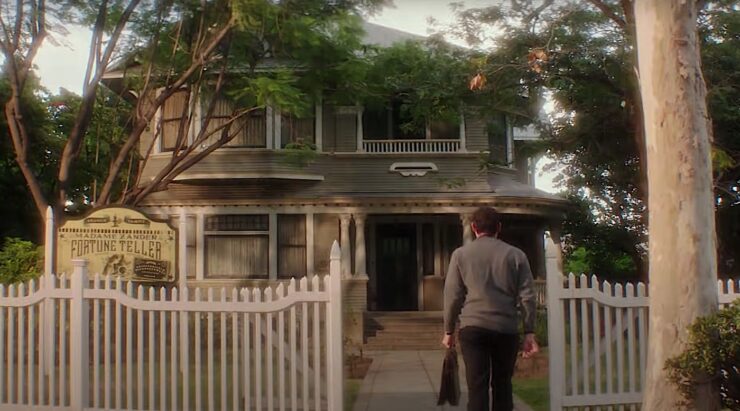
Here’s more fun with Catholicism from director Mike Flanagan! Our would-be exorcist Father Tom is the principal of the Catholic school that Lina and Doris Zander attend. Their widowed mother, Alice, is a professional psychic medium, and employs both girls in her staged seances. After little Doris starts acting, well, possessed as hell, her big sister Lina gives Father Tom pages of Doris’ automatic writing. A scene later, Father Tom drives over and pulls up to the house (in a fun, very dramatic nod to the taxi drop-off in The Exorcist), and has Doris do a seance for him. He proves that she’s channeling something—but not anything benevolent. Rather than setting up a meeting with the bishop, he leaves Doris alone and meets with Alice and Lina upstairs, where he tells them that: (a) a nun translated Doris’ automatic writing from Polish—a language she does not know and (b) they were dictated by a Polish WWII refugee/ghost who was (c) murdered by a Nazi… in this very house! (d) in a secret torture room! (e) that’s in their basement!
But since he’s outlining all of this in the house that has the ghosts in it, said ghosts overhear him and immediately possess him. Like, he barely gets the first line of Psalm 23 out before his eyes have gone dead white and he’s telling Alice that Doris is “…part of the walls now. And she told me the most wonderful, awful things…” He chases Alice and Lina with a comically huge knife, comes back to himself long enough to try to resist the demonic forces, and Doris throws him down the basement steps and kills him. All in about five minutes.
Vatican or Vatican’t? If only he’d called the Diocese before he went after Doris, maybe he would’ve survived.
How’s Your Faith, Father? It seems fine! But it also seems like he brought a spiritual knife to a spiritual gunfight.
You Can’t Spell Exorcism Without an S, an E, and an X: Father Tom, who became a priest after his wife died, takes Alice Zander out to dinner to offer emotional support, which is sweet, but this ends up being framed as two people sitting at what Young Leah would have called “a tablecloth restaurant”, with long-stemmed glasses of wine and candles and stuff, talking about how lonely they both are. They agree that in another life they might have fallen in love.
Rite or violence? We never get to know.
Quid tu hic? I have to admit, this one might be my personal favorite on this list. I love Mike Flanagan and all his works, and to the right kind of eyes, this movie’s hilarious. After all this slow burn tension of Doris’ possession, the way Father Tom gradually becomes more and more central to the plot, with his obvious decency and concern for the family, his off-screen occult detective work, the way he springs into action, only to be instantly crushed by the dark forces at work. If you watch a lot of possession movies, the subversion of the heroic priest character is just fucking fun.
16. Father Black — Agnes
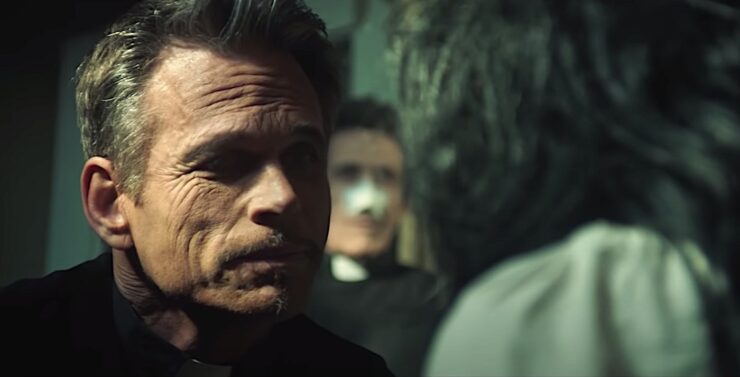
Agnes is the kind of weird little indie movie that I wish I’d seen at 3am at a friend’s house in high school. (Those days may be behind me, but for those of you reading, it’s on Hulu: Plan your slumber parties accordingly.) A dissolute priest is called in to exorcise a nun named Agnes whose erratic behavior might be possession, or it might just be the result of living in a very stifling convent. Things go awry, and the movie follows the nun’s best friend, Mary, through the aftermath. Chris Browning’s Father Black is a defrocked priest who is called in when the first priest, Father Donoghue, fails to clear Agnes of the demon. Father Black is a non-denominational freelance exorcist, who seems to make more appearances on tabloid TV shows than is healthy. He claims that his sister has been possessed by a demon since he was a little kid, and while he was never able to get rid of that demon, living with it his whole life has given him a special understanding of demonic nature.
Vatican or Vatican’t? He’s a defrocked priest! The Vatican has nothing to do with this—it’s all Father Donoghue’s fault.
How’s Your Faith, Father? I get the sense faith isn’t high on Father Black’s list of priorities.
You Can’t Spell Exorcism Without an S, an E, and an X: He’s accompanied to the exorcism by a mysterious hot woman, whom I’m assuming is meant to be his demonic sister? But there’s also a hint that there’s other stuff going on there.
Rite or Violence? He chokes Agnes when she doesn’t immediately respond to his other method: screaming at her.
Quid tu hic? He seems to have been successful with other exorcisms in the past! But alas, he does not distinguish himself here.
15. Father Donaghue — Agnes
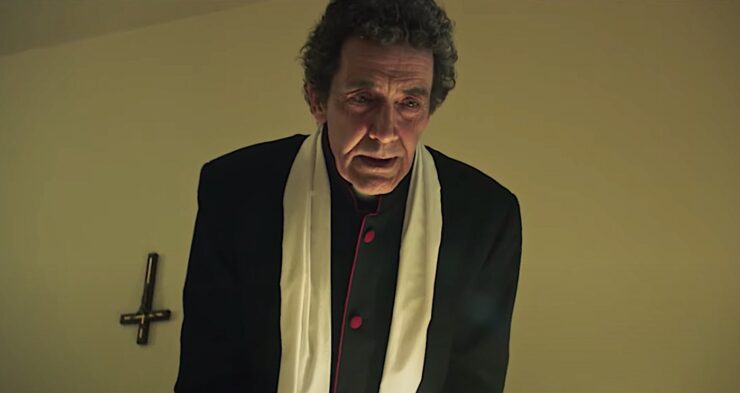
Father Donaghue starts out as the main character of Agnes, and the movie gives every indication that we’re meant to be seeing this case from his point of view. And then it all veers in a much more interesting direction.
Vatican or Vatican’t? The Diocese is planning to relocate him because of some earlier, um, improprieties. It’s unclear whether the accusations against him are fair or not, but this exorcism is meant as a punishment.
How’s Your Faith, Father? He makes it clear he doesn’t believe in demons, and it’s not really clear whether he still has any feeling for his job, or if he’s remaining in the priesthood because there’s nothing else he can do.
You Can’t Spell Exorcism Without an S, an E, and an X: Yeahhhh Father Donaghue seems to think that the Mother Superior wants to hook up with him? And, as is tradition, a lot of Agnes’ “erratic behavior” is R-Rated.
Rite or Violence?: His main methodology is to yell and get in Agnes’ face a lot, which does not go well for him.
Quid tu hic? Maybe he was a good exorcist once. Maybe he was a good priest once. But it’s hard to imagine.
14. Detective Kinderman — Exorcist III
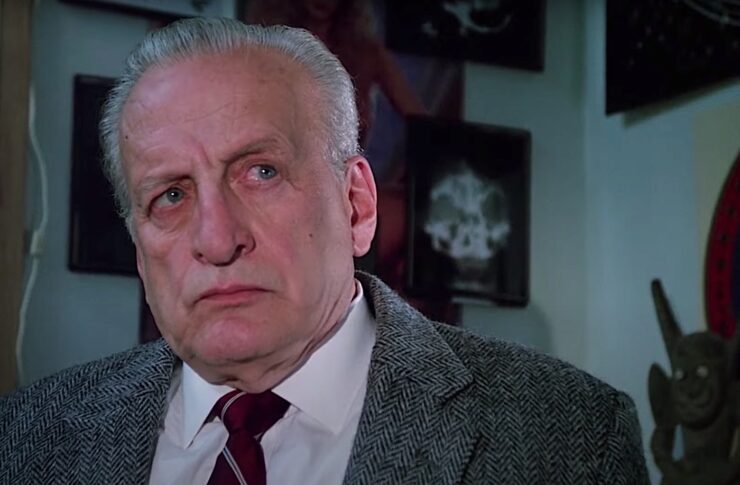
What’s this? A good sequel to The Exorcist? Exorcist III was plagued by studio interference and reshoots, but has since come into its own as a pretty great psychological horror film. It’s weird, bumpy, misshapen, full of odd pacing and inexplicable acting choices. And it all adds up to a gripping movie that expands on the original without desecrating its memory. George C. Scott’s Detective Kinderman investigates a rash of murders that seem uncannily similar to the “Gemini Murders” (a riff on the Zodiac Murders) that target religious figures and may have something to do with the exorcism performed by Fathers Lankester Merrin and Damian Karras fifteen years earlier. Then someone who looks suspiciously like the long-dead Father Karras shows up at a local hospital, and Det. Kinderman is on a collision course with demonic wackiness. He ends up assisting in an exorcism—kind of—and I really like him as a character, thus he shows up on this list.
Vatican or Vatican’t? Det. Kinderman meets with a bishop to discuss his suspicions about the latest rash of Gemini-esque murders. The bishop might be my favorite character in the movie: He’s hilariously deadpan about the murders, and about the supernatural activity that ensues, utterly unbothered when a clock stops, doors open on their own, an unseen spirit seems to rifle through a stack of his papers, and Creepy Childlike Laughter echoes through the halls. He also can’t be bothered to go to the hospital and check if a fifteen-years-dead priest is actually alive. Eventually we learn that the diocese is talking about sending another priest in, but I’ll deal with in an entry further up this list.
How’s Your Faith, um, Detective? Nonexistent! At least until he’s faced with the wrath of a demon, at which point he says he believes “in death. I believe in disease. I believe in injustice and inhumanity, torture and anger and hate. I believe in murder. I believe in pain. I believe in cruelty and infidelity. I believe in slime and stink and every crawling, putrid thing—every possible ugliness and corruption, you son of a bitch. I believe… in you.”
You Can’t Spell Exorcism Without an S, an E, and an X: Nope!
Rite or Violence? Pure violence. When Karras’ soul manages to get the upper hand over the Gemini, he yells “Now, Bill! Shoot me now!” And Detective Kinderman puts three bullets into his old friend’s body, thus theoretically freeing the souls of both men (and I guess maybe Pazuzu?) from Karras’ body.
Quid tu hic? Det. Kinderman is not an exorcist, but his method does seem to work, so he ends up in the middle. Exorcist Purgatory, hurrah!
13. Father Tomas Esquibel, Father Amorth’s Dumbass Assistant — The Pope’s Exorcist
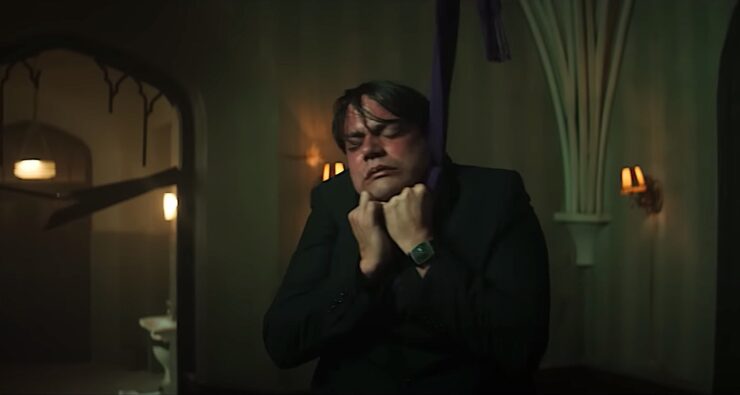
Okay, maybe that seems harsh, but Father Tomas, the hapless younger priest of The Pope’s Exorcist, starts off ridiculously under-qualified for the difficult life of an exorcist—let alone an assistant to Father Amorth, whose job is just exorcism. Here’s a brief rundown of Father Tomas’ greatest hits:
Father Amorth tells Father Tomas that he’ll need to confess before the exorcism, and the priest’s response is: “Now???” Just like that, with multiple shocked question marks. Not a good sign! When this professional priest is asked, “What prayer do you know that you could say, over and over, even under pressure?” this man—this priest—replies: “…the Hail Mary?” Even I could do that, my dude. And THEN he follows up with “But if it’s under pressure I would prefer to say it in Spanish.”
FFS.
Vatican or Vatican’t? The Vatican has approved the exorcism, and once Father Tomas gets his shit together they welcome him in as Father Amorth’s assistant.
How’s Your Faith, Father? By the time we meet him he’s decided to remain a priest, and says that as much as he loves his ex-girlfriend, he loves God more. But, as we soon learn, not enough to make a real confession of his affair with the girlfriend before agreeing to help exorcise a helpless little boy named Henry. smh
You Can’t Spell Exorcism Without an S, an E, and an X: Hoo boy. The whole problem with Father Tomas is that he had a long-running affair with a parishioner, whom he did love, but he didn’t want to leave the priesthood for her. He kind of fibbed about that to make her happy. He doesn’t confess this explicitly until after the demon uses her against him… and after he tries to choke the possessed kid to shut the demon up. and Father Amorth has to drag him off. Later, the demon sends a homunculus of his ex after him, and the tension is finally resolved when Tomas presses a crucifix against her until she explodes into a shower of blood.
Rite or Violence? Rite, except for the part where he chokes poor little Henry. And I guess THE BLOOD EXPLOSION, but that’s after the conclusion of the ritual.
Quid tu hic? He’s very bad at this until the last ten minutes of the movie, when he suddenly, inexplicably, knows Latin real well and can work nearly as Amorth’s equal. The Pope’s Exorcist is incredible and I want a thousand sequels.
12. Reverend Cotton Marcus — The Last Exorcism
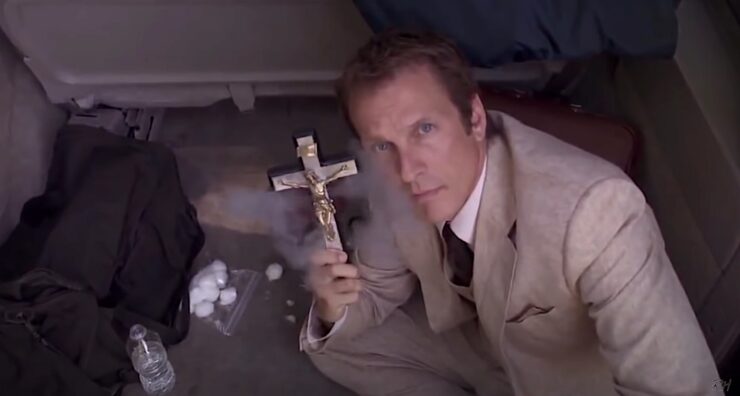
The Last Exorcism was maybe my favorite discovery in my research for this list. The movie is a found-footage horror, the footage being a documentary that Reverend Marcus is making with a pair of filmmakers to debunk exorcism stories. He recounts his journey from faith to skepticism, explains the popularity of exorcism across religions and denominations and chooses a random letter from his stack of exorcism requests, and off he and the doc crew go. The exorcism itself seems intense—demonic voices, shaking bed, smoking crucifix—but the scene cuts repeatedly to moments earlier in the day, when Marcus rigged the room up, played recordings of screams, and took his crucifix apart to show a micro fog machine inside.
Vatican or Vatican’t? Reverend Marcus makes a point of saying that the Catholic church does more exorcisms than ever, and that “everyone thinks [exorcism] is a Catholic thing cause they got the movie”—and the hint of jealousy in his voice is hilarious.
How’s Your Faith, Father? At the beginning of the film, it’s nonexistent. That seems to change in the last few minutes, however.
You Can’t Spell Exorcism Without an S, an E, and an X: The movie plays up the sexualization of exorcism, with Marcus telling his client, Lewis, that a demon is “defiling” his daughter, and then staging the exorcism in her bed, only after grabbing one of the posts, rattling it, and commenting “Yeah, this’ll shake nicely.” There are also a couple of different sexual revelations about the possessed person later on in the film, but talking about them will spoil the movie, and this is one you need to see with fresh eyes.
Rite or Violence? I think “violent rite” is probably the best way to sum it up: Reverend Marcus hoots and hollers and uses a ton of lo-fi special effects to create drama—but he’s the one who immediately ups the stakes by telling Lewis that the demon will have to be killed if it can’t be exorcised, which results in the man threatening his daughter with a shotgun when he thinks the rite hasn’t worked.
Quid tu hic? Reverend Marcus’ exorcisms, while fake, also seem to work for people. By the time he agrees to the documentary he’s been a professional exorcist for decades. Plus this movie’s great! Much like with Agnes, it was really fun to realize about five minutes in that I was watching something unique. The more I thought about it the further up the list it got.
11. Ed and Lorraine Warren — The Conjuring Series
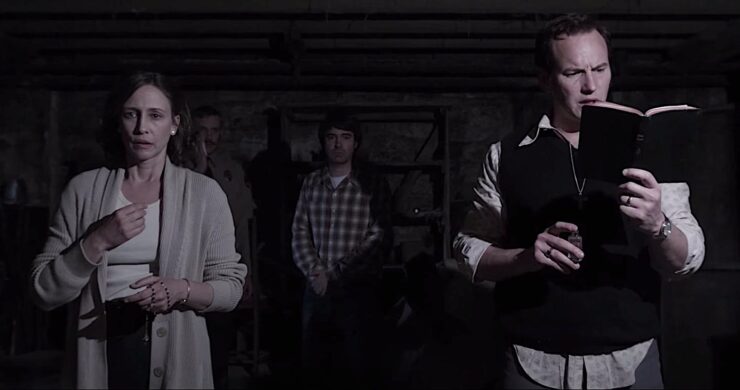
The fictional versions of Ed and Lorraine Warren are an odd case. They’re both devoutly Catholic, but they’re a married couple with a kid, and neither of them are ordained in any way. Lorraine can see spirits, Ed believes in her, and the two become freelance mediums and then… keep some of the haunted stuff they find. And make a museum out of it. That they keep in the basement of the home where they live with their small daughter. Wacky shit! Their exorcisms end up being a hodgepodge of Spiritualist seance and Roman Ritual, with Lorraine using a rosary like a dousing rod to find ghosts, occultists popping up and cursing people, and the odd demonic nun appearing in dreams and paintings.
Vatican or Vatican’t? Since they aren’t officially exorcists, the Warrens’ involvement in cases usually comes about when the Church asks them to investigate and gather evidence for an “official” exorcism—except then they inevitably have to do it themselves! Every single time! What are the odds?
How’s Your Faith, Happily Married Couple? Nothing will shake the Warrens’ faith in God, each other, or eye-watering ‘70s fashion.
You Can’t Spell Exorcism Without an S, an E, and an X: Part of the appeal of the Warrens is their devotion to each other, so there is always some sparkiness between them. (Ed matches his ties to Lorraine’s dresses! FFS!) But these movies don’t sexualize the possessed people at all.
Rite or Violence? Ed always starts out reciting the Rite, until demonic shenanigans mean that Lorraine has to save Ed and the possessed person with the power of LOVE.
Quid tu hic? Their methods are a little shaky, but to hear the Warrens tell it, they’re very good at their job.
10. Father Richard Moore — The Exorcism of Emily Rose
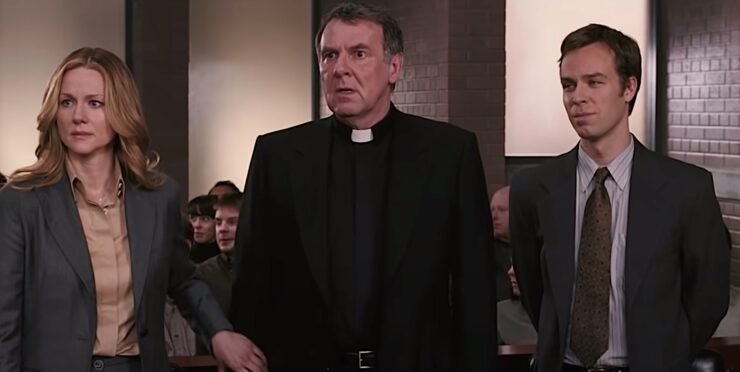
Emily Rose went off to college, got possessed, and came home. That first semester’s always tough. The family’s parish priest, Father Moore, tried to exorcise Emily, but the ritual failed after months and Emily’s body gave up. Now the priest is on trial for negligent homicide. I hadn’t watched this movie in a while, and I was surprised by how uncanny it feels—and not always in a good way. What year is this supposed to be? Why does the Church have tape recordings of the exorcism but not video? Why is it always raining? Why are digital clocks forces of evil in this world? Why is Emily so disconnected from everyone except her sisters? But most of all, what the hell legal system is this supposed to be? The priest is being prosecuted, but the family isn’t, their other (underage) daughters are apparently still living with the parents who approved the exorcism, the Diocese doesn’t want to let Father Moore go up on the stand, but then when he does, Emily’s final letter to humanity like kicks off a tiny spiritual revival or something?
I don’t know. I’ve liked some of Scott Derrickson’s other work, and I wanted this to be a) scarier and b) a way more thorough exploration of the legal issues around exorcism.
Vatican or Vatican’t? Vati-did, but then the exorcisée went and died, and now the diocese is paying the legal fees and pressuring the lawyer to keep Father Moore off the stand so they can make this potential murder case go away.
How’s Your Faith, Father? Father Moore absolutely believes that he did the right thing, that Emily Rose was basically a saint, and that God wants her story to be told.
You Can’t Spell Exorcism Without an S, an E, and an X: At first there’s an idea that moving to “the City” and being around boys might have something to do with Emily’s erratic behavior, but Emily’s boyfriend loves her and stands by her through the exorcism. They seem to have had a totally chaste relationship, and it’s heavily implied that he’s become more religious because of her death. Her actual exorcism isn’t sexualized at all, it’s just scary and/or sad.
Rite or Violence? Father Moore stolidly recites prayers, instructs the others to do the same, and trusts in the process to work without getting angry.
Quid tu hic? Father Moore is a perfectly adequate exorcist, but seemingly the Virgin Mary (???) decided that Emily Rose has to die to restore people’s faith (?????) so he’s kind of hosed.
9. David Acosta — Evil
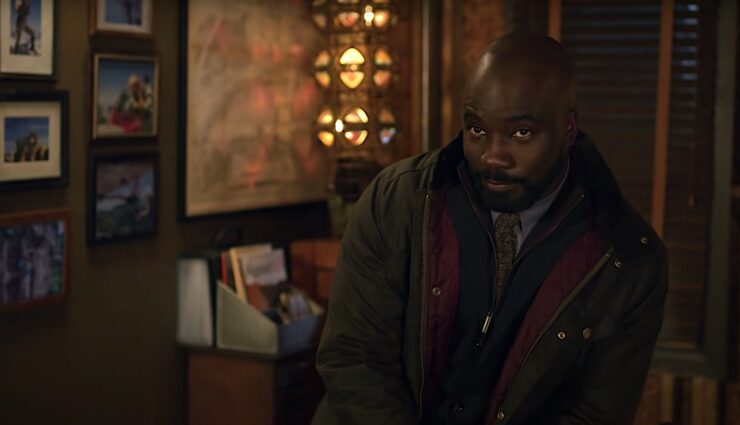
Evil is one of the best shows on television. Father David Acosta is a seminarian, then later a priest, who is tasked with investigating possible demonic activity alongside forensic psychologist Dr. Kristen Bouchard, and jack-of-all-tech-stuff, Ben (The Magnificent) Shakir to try to tease out supernatural evil from psychological disturbance and/or hoaxes. Occasionally, he’s called into a full official exorcism, and sometimes Dr. Bouchard is asked to observe.
Vatican or Vatican’t? Father Acosta works directly with the Church in New York City. They gave him a cool loft space to live in! It’s pretty sweet.
How’s Your Faith, Father? Complicated. He is usually pretty good on that, but when he feels himself doubting, he brews hallucinogenic tea to try to have direct experiences of the Divine—not a terribly sustainable model if he’s going to make this priesthood thing a career.
You Can’t Spell Exorcism Without an S, an E, and an X: Father Acosta used to be married, is still in pretty deep mourning for his wife, and has also been in therapy for sex addiction. There is a lot of tension between David Acosta and… everyone, really—but he checks all that at the door during exorcisms.
Rite or Violence? Like everything else about David, he hopes that if he just cares at you hard enough, the demon will leave. This hasn’t worked yet! But maybe next season.
Quid tu hic? Father Acosta is trying really hard, and the show is great.
8. Father Tomas Ortega — The Exorcist TV Series, Criminally Cancelled After Only Two Perfect Seasons
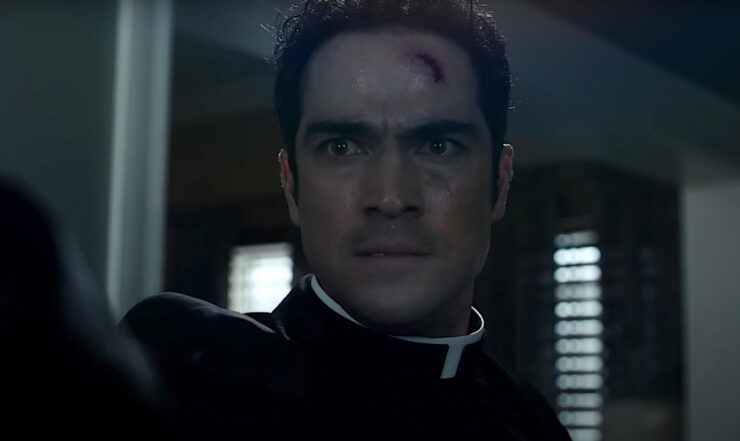
Father Tomas is working hard to breathe new life into an underserved parish in Chicago, while harboring serious guilt over leaving his Abuelita to die alone in Mexico City, and over the feeling he has for his college sweetheart, and for how desperately he wants to feel that God has a special purpose for him. This makes him a perfect protagonist for a show about exorcisms. He starts as an assistant to Father Marcus Keane (whom we’ll see higher up the list), and like Father Amorth’s Dumbass Assistant, Tomas allows his judgement to be clouded by all of his unresolved feelings. But because The Exorcist TV series is also an actually pretty serious exploration of faith, this is handled way better. (Honestly I think it does it even better than Fleabag, which seems to be other people’s go-to post-Thornbirds Hot Priest experience) And because it’s a TV show, Tomas is given room to change and grow over two seasons. (It should have been more.)
Over the course of season one, Father Tomas: literally takes money from the Devil; has an affair with a married woman; lies to EVERYBODY; gets in a fistfight at a bodega; and puts his own pride and need to feel special above the needs of his parishioners and friends.
But after all that he comes through in the clutch, and having watched Marcus’ hybrid technique, tries something new, which works to save a family and launch him into a new life as a travelling exorcist who fears nothing but the unknowable whims of television executives.
Vatican or Vatican’t? Part of season one turns on Tomas gathering evidence for an exorcism, but the higher-ups mostly want him to leave that case alone so they can promote him to a better parish and make him the face of a younger, hipper, more youth-friendly (but not actually changed in any significant ways that would help people in the modern world) Church.
How’s Your Faith, Father? Not basic faith so much, but Tomas struggles with his calling, and with a gnawing need to feel chosen.
You Can’t Spell Exorcism Without an S, an E, and an X: Tomas’ unresolved emotions and weakened mental state lead to a disturbing scene where the demon gets in Tomas’ head, transforms the possessed girl into the woman Tomas is sleeping with, and some stuff seems to be just about to happen when Marcus comes in and stops it.
Rite or Violence? He follows Marcus’ lead until he has to do a solo exorcism, and then he turns out to rely more on compassion and love than on everyone further down this list.
Quid tu hic? He gets off to a rough start, but by the beginning of season two he’s an excellent exorcist.
7. Father Damian Karras — The Exorcist
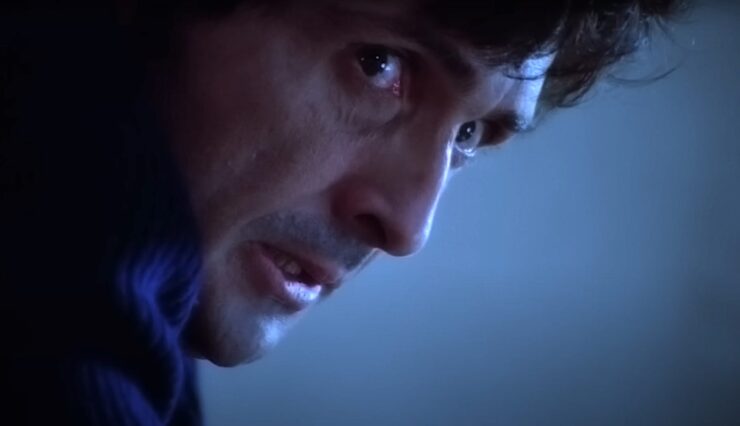
Let’s be honest: Father Damian Karras shouldn’t be doing an exorcism. His psychology background makes him extremely suspicious of the idea of demons, which, in secular life, is good, but here it kind of makes him more vulnerable to the demonic attack. His mother just died, and he blames his vow of poverty for making her last years harder than they should have been, so he walks into Regan’s room with years of guilt for the demon to feast on. And finally his faith is in tatters.
At the beginning, before he talks to the diocese, he’s light and somewhat amused when he speaks to Regan. He treats the conversation like banter between a pair of equals. Which, of course, the demon is able to use that to rattle him. He offers to do the exorcism despite having no experience. He tries to get Merrin to engage with him about “the case”, still not understanding that he’s in a different reality now. And during the ritual itself, he allows himself to be distracted by the demon’s theatrics, which throws the rhythm off. He is completely undermined by the demon mimicking his mother, until Merrin finally throws him out. (Which was, of course, the plan all along, because once the demon gets Merrin alone he torments him into a heart attack.) When Karras finds Merrin dead, he attacks Regan, punches her, chokes her, and screams at the demon to take him instead. Presumably Pazuzu think Karras is an easy mark, but the priest manages to control himself just long enough to jump out of Regan’s window, taking the demon with him.
Vatican or Vatican’t? Father Karras collects evidence, presents it to his higher-ups, and asks to do the exorcism himself. They, wisely, turn that request down, but agree to approve an exorcism by Father Merrin.
How’s Your Faith, Father? Uhhh, pass! No, he’s not doing well. Years of counseling depressed priests has taken its toll, and he admits over drinks with a friend that he thinks he’s losing his faith. (And that’s before he comes face-to-face with pure evil.) There’s an argument to be made that the exorcism restores it, kind of, and that there’s a somewhat redemptive ending here, that doesn’t do much to offset the bleak tone.
You Can’t Spell Exorcism Without an S, an E, and an X: Karras seems to be doubting the core of his faith, but the worries he expresses are all centered on poverty, not chastity. Watching it again, I’d say the movie hints that Father Dyer might have some romantic feelings towards Karras, but the two express their love through friendship, and there’s no indication that chastity is an issue for either of them.
Rite or Violence? He follows Merrin’s lead for the most part and relies on the Rite, until he finally snarls that the demon isn’t his mother and Merrin kicks him out of the exorcism. When he finds Merrin dead he loses it, hits Regan, and chokes her while demanding the demon take him instead.
Quid tu hic? Why is he here, instead of a few slots higher? He is the all-time classic example of the tortured-priest-testing-his-faith-with-an-exorcism. And on the one hand, he commits suicide to save Regan. That’s dedication! But still— his exorcism style leaves a lot to be desired, and the film ends with the demon having taken the lives of two priests, and coming back even stronger in Exorcist III and The Exorcist TV spinoff. So this isn’t exactly a win.
6. Paul Morning — Exorcist III
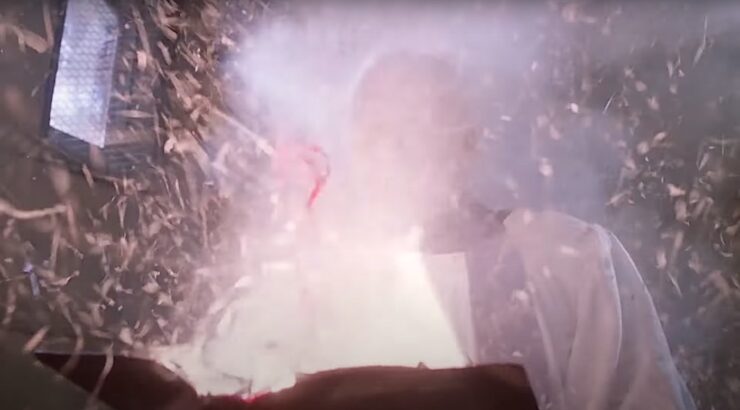
Seemingly without waiting for orders from Diocese, or any knowledge whatsoever of the case, Father Morning dusts off his valise and marches down to the hospital to wrap up the studio-approved ending of Exorcist III.
Vatican or Vatican’t? The higher-ups talk about sending Father Morning in and discuss his previous experience. Then he seems to just know where to go, and shows up in the Gemini’s hospital room alone. Did the Church send him? Did Pazuzu lure him in, as he lured Det. Kinderman? Was this one of those wacky ineffable capital-P Plans? Or was it studio interference?
How’s Your Faith, Father? Father Morning is introduced sitting alone in his room, reading the Bible, while the baby bird he’s nursing back to health chirps on the windowsill. Within a few moments the bird is dead and Father Morning’s crucifix falls off the wall, which he interprets as signs that Evil is afoot in the world.
You Can’t Spell Exorcism Without an S, an E, and an X: Does not come up!
Rite or Violence? Rite! He recites the prayers even after the demon has flung his body up onto a burning-hot ceiling and cooked his flesh.
Quid tu hic? He’s clearly an experienced exorcist, but he’s also clearly outmatched here. At the same time, he manages to come back to consciousness just long enough to tee up Detective Kinderman’s gun-based exorcism method, thus he just misses the Top Five.
5. John Constantine — Constantine
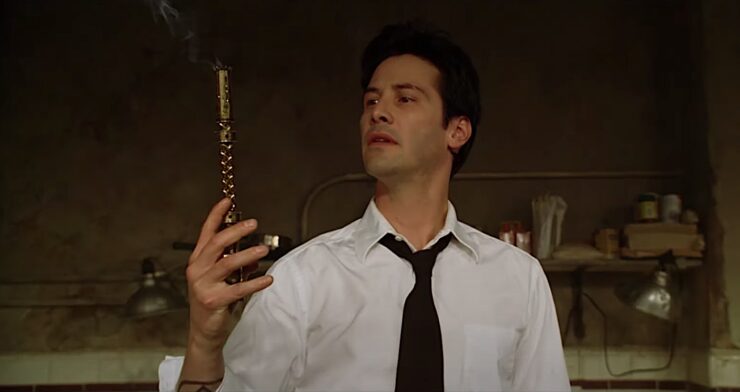
I’ve written before about my deep love for this film. Genuinely I think I could put it on at any time of day and any point in its runtime and sit and watch it. The only true exorcism is the opening gambit, when John exorcises a demon from a young girl because his friend, Father Hennessy, can’t get rid of it. John starts off using a basic Catholic rite before going a little more occult and trapping it in a mirror, then defenestrating the mirror to shatter the demon to bits.
Vatican or Vatican’t? Hennessy is the one who calls him in (per Ebert’s negative review of the film: “There is a priest in the film, the alcoholic Father Hennessy (Pruitt Taylor Vince), whose name, I guess, is product placement.”) but beyond that I can’t imagine the Vatican wants anything to do with John Constantine.
How’s Your Faith, John? Again, that’s part of the problem: John knows there’s a God, and a Devil, and thus can’t have faith, which is presented as why he can’t really repent and is thus damned with no hope of parole. This idea seems to be rejected by the end of the movie, however.
You Can’t Spell Exorcism Without an S, an E, and an X: John’s not a priest, so this wouldn’t be an issue, but the funny thing is that the movie subverts the expectation that the two blisteringly hot leads will get together, because when Angela tries to flirt with John, he gently but consistently rebuffs the attention. (Maybe this is an AU where he and King Shark are monogamous?) And in the film’s one true exorcism the victim is a young girl, and the film completely sidesteps all the gross exploitation that often comes with these scenes.
Rite or Violence? John uses a mix of occult stuff and Catholic stuff, and at one point John punches the demon’s face/the girl’s throat. This subdues the demon for a second, and seemingly doesn’t do any lasting harm to the girl.
Quid tu hic? On the one hand, Constantine probably doesn’t belong on this list. On the other, the one time we see him do a traditional exorcism it works in less than ten minutes. Some of these other people takes weeks to exorcise somebody! I can’t ignore that kind of efficiency.
4. Father Amorth — The Pope’s Exorcist
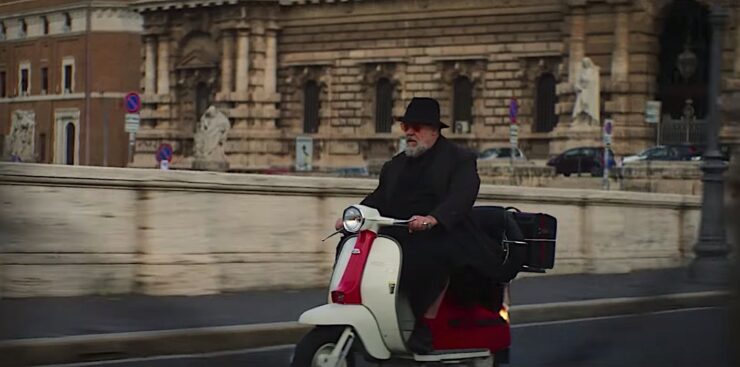
I love this movie with my whole heart.
Vatican or Vatican’t? He’s THE POPE’S EXORCIST, so yes he has Vatican backing. But! There are dark forces at work trying to undermine him and his relationship to the Pope—dark forces in this case being Cardinal Sullivan, a snotty American who acts like nothing so much as an uptight college president in an ’80s “snobs vs. slobs” movie. (At one point Sullivan visits the Pope in the hospital, and when Il Papa tries to tell the Cardinals to “warn Gabriel,” Sullivan responds by screaming “Amorth??? What trouble has he got us into this time???” directly into the mortally ill Pope’s face. The Pope replies by projectile vomiting blood at him like one of those iguanas that shoots salt out of its nose.
Also, according to this movie, the Devil totally infiltrated the Church and caused the Spanish Inquisition, so you can stop blaming that on them now, thank you.
How’s Your Faith, Father? Amorth tells everyone who will listen that his faith is just fine, it’s these damned Vatican conspiracies that keep messing everything up.
You Can’t Spell Exorcism Without an S, an E, and an X: Once Henry is possessed, he gropes his mom (ick) and the demon tells Father Amorth: “I’m going to fuck you—you’ll sense yourself coming and you’ll hate yourself for the release you feel, when I fuck you” which manages to be maybe the best sexually explicit dialogue in an exorcism since The Exorcist? We learn that the girl Father Amorth failed had been sexually abused, and when the demon uses her memory against him she’s usually naked and/or out of breath and/or… biting the heads off of birds.
Rite or Violence? Rite! He repeatedly tells people that they have to be “implacable” and “relentless” in prayer, as that wears the demon down. His other innovation is humor, as he tells people “The Devil does not like jokes” and the demon explicitly threatens him over it at one point, saying “You can’t hide behind your jokes forever, Gabriele.”
Quid tu hic? He travels from Vatican City to the mountains of Spain on a Vespa. This movie is absurd, but Father Amorth is the hero we need.
3. Lankester Merrin — The Exorcist
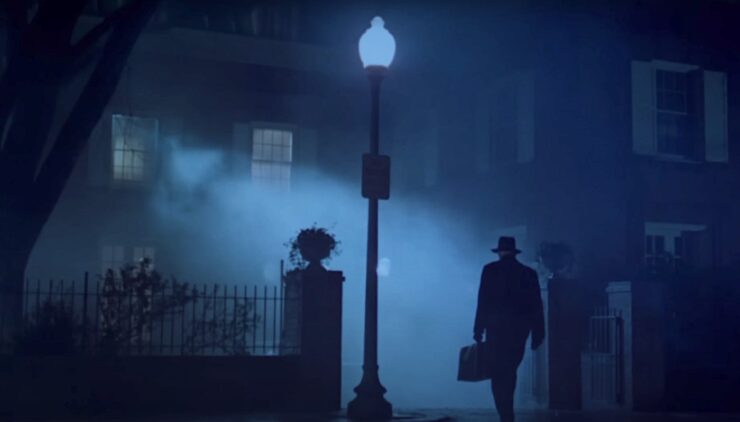
Father Merrin appears in three different films in the Exorcist series—The Exorcist, where he’s an elderly man played by the not-elderly Max Von Sydow in age makeup, and then as a younger man played by Stellan Skarsgard in both Exorcist: The Beginning, directed by Renny Harlin, and Dominion: The Prequel to The Exorcist, directed by Paul Schrader. For the purposes of this list, I’m gonna ignore The Young Father Merrin Chronicles.
Of all the people on this list, Merrin might be the most effective exorcist. I’m choosing to ignore the two prequels, mostly because I don’t want to watch them again, but suffice to say, Merrin has Seen Some Shit. The Merrin we meet in The Exorcist is elderly, weakened by a heart condition, and wearied by evils both natural and supernatural. He’s an archaeologist and author, and he’s seemingly allowed by his superiors to travel between dig sites and writing retreats. And as an exorcist he is calm and methodical, does not engage with the demon, takes the time to wipe Regan’s face, and sees the little girl trapped inside a demonic exterior. No matter how much green puke flies through the air, he remains unflappable.
Vatican or Vatican’t? The Diocese has approved the exorcism, and are the ones who call Merrin in when they, quite correctly, realize that Karras can’t handle it alone.
How’s Your Faith, Father? During a deleted scene that was restored in the Director’s Cut, Merrin explains to Karras that he thinks the demon attacks innocence to chip away at regular people’s faith, but Merrin seems to just accept this as the price of the ticket. He trusts the ritual to defeat the demon, if he can just keep his ticker going long enough.
You Can’t Spell Exorcism Without an S, an E, and an X: Not in this outing! There is some disturbing psychosexual drama with possessed people in Exorcist: The Beginning, and Dominion: The Prequel to The Exorcist, which are both kind of sad existential erotic thrillers, but Father Merrin has clearly left all that drama behind him.
Rite or Violence? Rite Rite Rite. The thing that’s cool about Father Merrin, and why he’s so high up the list, is that he is absolutely implacable. Does he show fear and disgust? Sure! He’s human after all. But he is determined to beat Pazuzu and save Regan, and never lets himself fall into hysterics or do anything that might harm her.
Quid tu hic? Merrin lands in the third slot for two reasons: (1) I cannot deny the power of that iconic poster shot, and (2) After Merrin kicks Karras out of the room, he walks over to Regan on the bed, kneels beside her, and begins the ritual again. He has no back-up, no help. He’s alone with a demon. And Merrin, with zero hesitation, reached over and holds Regan’s hand.
2. Mother Bernadette — The Exorcist TV Series, Criminally Cancelled After Only Two Perfect Seasons
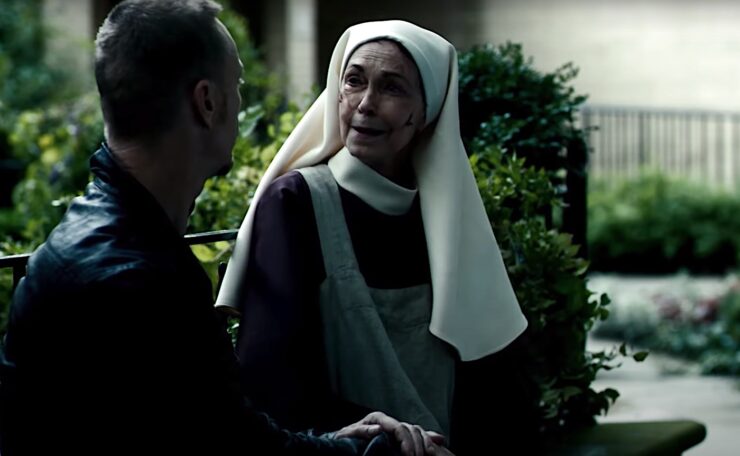
Mother Bernadette is the leader of an abbey of cloistered nuns. She and the rest of the sisters have pioneered a very different exorcism technique. The sisters form a circle and pray in unison, while Mother Bernadette steps into the circle to confront the possessed person, not by screaming in their face, but by telling them they are loved and forgiven. If the possessed person lashes out, she simply does her best to step out of the way (this doesn’t always work—she’s covered in scratches and scars) and meets violence with an embrace when she can manage it. The goal is to forgive the demon itself, freeing the possessed person, and possibly redeeming a creature thought of as pure evil in the rest of The Exorcist‘s universe.
Vatican or Vatican’t? After Father Marcus Keane is excommunicated (it’s a long story), his superior, Father Bennett, sends him to Mother Bernadette, hoping that he’ll pick up some of her skills and continue his work as an unofficial rogue exorcist.
You Can’t Spell Exorcism Without an S, an E, and an X: According to Mother Bernadette, you can absolutely spell exorcism without those letters.
Conflicted Faith? Nope.
Rite or Violence? Neither! What makes the Abbess and her sisters so amazing is that they use pure compassion. While they do recite a couple specific prayers that emphasize Mary, they rely more on the power of love and forgiveness to drive the demon out.
Quid tu hic? Mother Bernadette is technically probably the best exorcist on the list, and the only one with a truly revolutionary exorcism style. She only misses the #1 slot because Number 1 is…
1. Father Marcus Keane — The Exorcist TV Series, Criminally Cancelled After Only Two Perfect Seasons
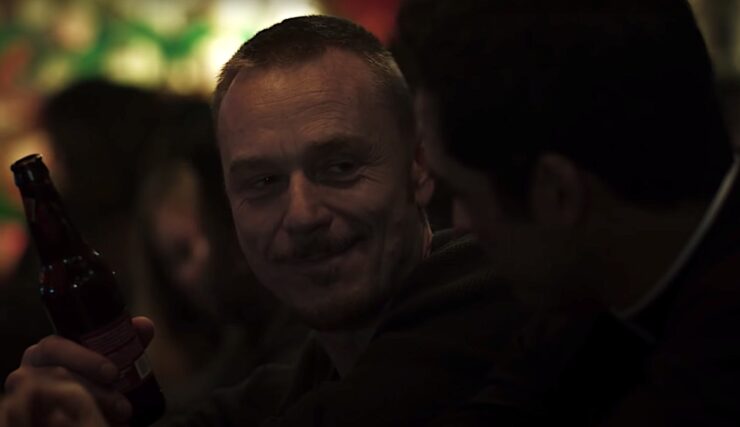
Father Marcus is a full-time exorcist. He was sold to the church out of foster care when he was a child, trained in the classic horror-movie exorcism technique, and is sent from place to place battling demons. We meet him when he’s on the way to a family in Mexico City, and soon we’re in full Exorcism Mode: blankets tacked up over the windows, filth and flies everywhere, kid tied to a bed, bowl of water and wrung-out-rags to towel to soothe the afflicted’s brow, the whole bit. And Marcus is clearly good at his job. But then, it fails anyway.
The failure sets Marcus on a course to meet Father Tomas, work with the Rance family, become entangled in a shadowy conspiracy, and begin a new life as a travelling exorcist who only works for the church in a clandestine capacity.
Vatican or Vatican’t? They can, until Marcus pisses them off too many times and they fire him, but they also secretly want him to keep doing his job in an unofficial capacity. This leads to problems in season two.
How’s Your Faith, Father? Even when he’s captured and tortured by Chicago’s leading Satanic cult (it’s a long story), he laughs in their faces and makes it clear he’s fine with martyrdom.
You Can’t Spell Exorcism Without an S, an E, and an X: The demon tries to taunt him by offering Casey to him, then follows up with “But girls were never your flavor, were they?”—but Marcus’ sexuality is a non-issue. While he’s been dedicated to the church since he was a kid, he’s queer, and fine with it. He only kind of starts flirting with men after he’s been excommunicated.
Rite or Violence? The only time he resorts to violence is when he pulls a gun on a superior who tries to stop an exorcism, because he still believes he can save the victim. Oh, and he stabs a dude to death with a cross to stop the man from assassinating the Pope. Gosh I love this show.
Quid tu hic? Father Marcus is one of my favorite characters ever. (Here, read an interview with actor Ben Daniels about how great he is!) The longer I sit with the show, the more I like what it tried to do, and what it often succeeded in doing. Marcus is an openly queer, extremely snarky, bitchy, depressed, traumatized person. He’s a priest because he was sold off to the church as a child. He is devoted to God but doesn’t give a shit about hierarchy or regulations or judging other people’s behavior. Halfway through season one, right after he’s been excommunicated (again, long story) we find him sprawled in the back pew of Father Tomas’ church, drinking whiskey from the bottle and considering his options. At one point he turns around and snarls “shut up” at a picture of Jesus hanging on the wall behind him.
I mean.
But also he’s the only exorcist on this list, aside from Tomas, who grows and changes over the course of his work. When we first meet him, his exorcism technique is pretty standard at the beginning—tie the possessed person to the bed, yell at the demon, attempt to comfort the possessed person when the demon subsides—but when he’s sent to Mother Bernadette, he mostly drops his bitchy exterior and learns from her methods. He doesn’t give up on Casey Rance even when the Abbess, Tomas, and Angela all think she’s gone for good. He kind of… consecrates, like, a third of Lake Michigan at one point? He makes jokes under torture? He takes break from exorcising demons to blast Northern Soul?
WHY WAS THIS SHOW CANCELLED.










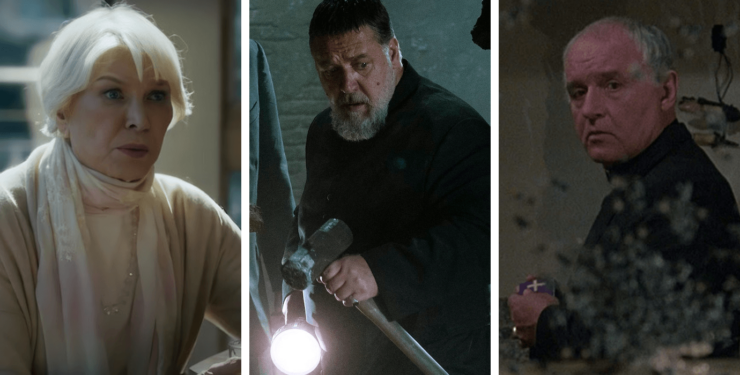
The two best parodies of the opening scene from THE EXORCIST are new QUANTUM LEAP’s Halloween episode last year and the first episode of SURREALESTATE.
In the real world of the paranormal, the Catholic Church is no longer the go-to for exorcisms. Too much bureaucracy. The demon would die of old age before they showed up in most cases. Demonologists, Episcopalians, and some Fundamentalist churches are now the exorcists of choice.
The exorcism episode of the Angel TV series (Season 1, Ep 14: “I’ve got you under my skin”) is also quite delightful. Someone in the family is possessed. Who is it? And who’s gonna exorcise them? How’s the titular vamp with a soul gonna handle all the catholic imagery?
It’s good stuff. I’d rank the person who ends up doing the exorcism pretty high, even if they drop the Latin for a good old, “Now get the hell out!”
What no Leslie Nielsen as Father Jebediah Mayii in Repossessed?
@1. Mbyerly: Episcopalians? Much love to Diet Church of England (“Anglicanism, Royalty-free!”) but I always thought they were too darned Progressive to put much faith in Exorcisms.
I am, in all honesty, at least a little bit charmed to learn that I was mistaken all along.
Also, I really do need to see THE POPE’S EXORCIST.
I absolutely DID need to see THE POPE’S EXORCIST and it was Good. So delightfully binkey-bonkers Good.
I do suspect that Fra Gabriel and Fra Tomas may have been just a wee bit Prideful to suppose that none of those 199 hellholes they were pointed at by the end of the film had been given a good seeing-to in the 400-odd years since they’d been mapped out, though.
@@.-@. Diet Light Catholics for the win!
@@.-@ I’ve read two rather interesting books by English Anglican priests who perform exorcisms. They tend to use the term Deliverance, like many Fundamentalist/Evangelicals do. The photo of one priest looks a lot like Terry Jones to me, which makes me deeply regret that Terry Jones never got a chance to play a Priest/Exorcist (And now for something completely possessed).
There was an Exorcist tv series? When/where?
Too much focus on the Exorcist franchise. What about Martin Shaw as Father Jacob in Apparitions?
Given the man performs a Black Mass at the end of his one and only season, I’m afraid we’d have to mark the poor man rather closer to the bottom of the list than the top.
*Clicks tongue x3* This list is too westerncentric. Shigeo Kageyama (Mob Psycho 100) would blow all these folks out of the water…literally.
I have seen THE POPE’S EXORCIST and it was delightful – let me pay the eponymous character my highest compliment and say that one would dearly love to see him meet HELLBOY (The two of them would be an absolute hoot together).